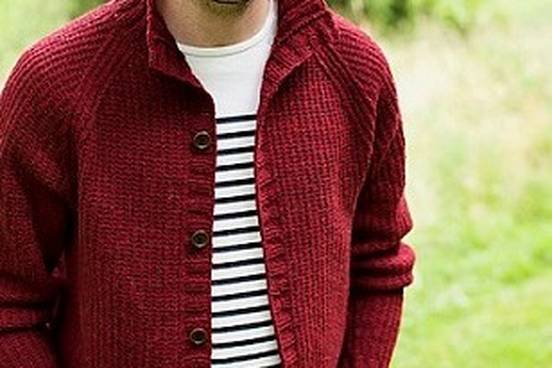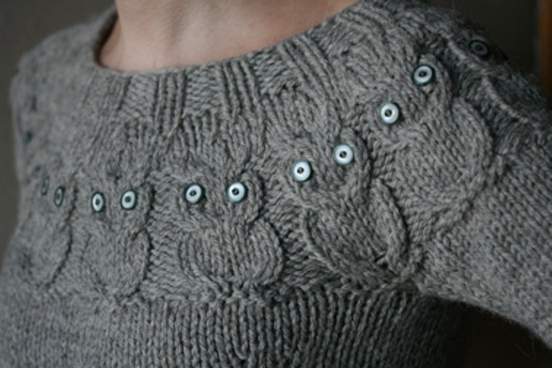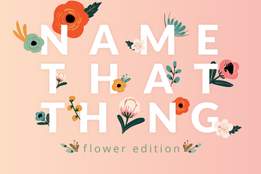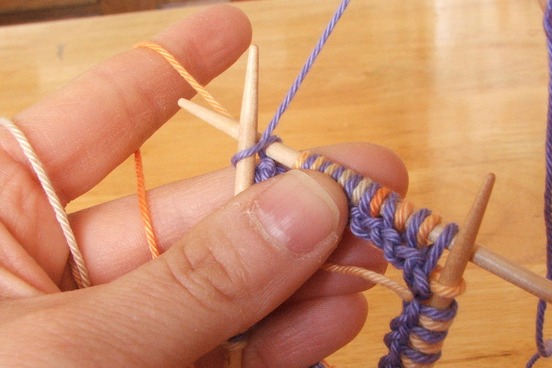
Knit
The word that started it all, the verb knit has been used in English since about 1000 AD. It derived from the Old English word cnyttan, which means "to tie in a knot," which was its first meaning. By the 1300s, the verb referred to tying string or thread into a net, and in 1530, we have our first use of knit to refer to the creation of an object by weaving together a series of interlocking loops using two needles ("I knyt bonettes or hosen.")
From the verb, we get the noun knit showing up in the late 1500s. It initially referred to a knit stitch, one of the two foundation stitches that make up all knitting (as in, "work in knit for two rows"), then came to be used for knitted fabric ("knit stretches more than lawn") and items made by knitting ("hand-wash delicate knits").
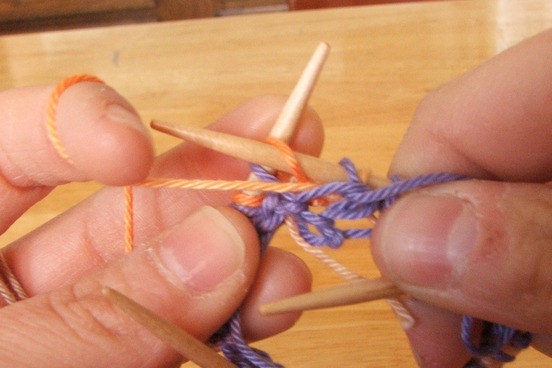
Purl
If you can knit, you can also purl. Purl is the word we use for the second foundation stitch in knitting, and it dates back to the 1300s. But like its companion term, knit, it didn't originally refer to the stitch. Purl first referred to gold and silver thread used for embroidery, and then for the embroidery itself. Likely because of the preciousness of silver and gold, purl embroidery was often done as edgings. By the early 1500s, the word purl referred to a particular kind of lacework done as an edging.
The first use of purl to refer to the knitting stitch comes from what scholars believe is the first written knitting pattern extant: a pattern for making stockings from the collection of cures called Nature exenterata. At the end of the book are helps for the housemistress—everything from advice on breeding horses to making dyes to knitting patterns. Though the pattern is incomplete by modern standards, its language is contemporary: "knit plain round til you come again to your heel-needle, then make one purl at the beginning of your heel-needle, then take up a stitch between the two purls and work it plain." The verb purl, which dates back to the 1500s, mimics the development of the noun: it was used first of embroidering with silver or gold thread, then of making a purl stitch ("purl two, knit one"), and then of knitting in purl stitch ("purl until you reach the stitch marker").
There is another purl that refers to the swirl of a river and the soft sound of a swirling river, but etymologists think that it is unrelated to the knitting purl.

Swatch
Knitters know that, before they knit something, they should knit up a gauge swatch. A swatch is a small square of fabric that is knit up in the given pattern using the needles and yarn intended for that project. A swatch tells the knitter how the knitted item will look in that particular yarn and at that particular gauge (that is, the number of stitches per inch). Some knitters regard swatching (the process of knitting a swatch) as a tedious waste of time and yarn. What are you going to do with all those swatches when you're done?
When swatch first entered English in the 1500s, it named something very useful—a tag or tally people attached to cloth they were sending to the dyer to mark ownership. Dyeing was a time-intensive process, so dyers dyed many merchants' stock at the same time. Owners would collect their dyed cloth by finding the cloth with their swatch on it.
In short order, swatch was applied to any small sample of fabric. The verb, while common among knitters and crocheters, is not well-known outside of fiber arts.
The art of knitting is much older than the terms associated with it. Take, for instance, cardigan. Though knitted jackets or sweaters that were split down the front go back several centuries, the name cardigan wasn't applied to these sweaters until 1862.
The cardigan was named after the seventh earl of Cardigan (which was a county in Wales). James Thomas Brudenell was known throughout his lifetime as a sartorially savvy gentleman, and his name was originally applied to a knitted wool vest, split down the front, that kept the cold away during the Crimean winters. Over time, the name cardigan came to be used of any similar knitted vest or sweater.
Lord Cardigan also has another claim to fame: he was a commanding officer in the Crimean War, and the leader of the infamous Charge of the Light Brigade, immortalized in poetry by Alfred Lord Tennyson.
By remarkable coincidence, the word raglan honors the name of Cardigan's commanding officer at Balaclava, the first Baron Raglan, Fitzroy James Henry Somerset (1788–1855). During the Crimean War, Raglan wore a loose-fitting overcoat with sleeves that extended all the way to the neckline instead of stopping at the shoulder. Originally raglan referred to the overcoat; it now can also refer to the style of sleeve ("a sweater with raglan sleeves") or a garment that has raglan sleeves ("a raglan cardigan"). Raglan was first used in print in 1857.
The Crimean War was an unusually fertile breeding ground for new fashions, which were a response to the cold weather encountered by the British troops. The village of Balaclava, the site of a battle where Cardigan's Charge of the Light Brigade happened, was also taken as the namesake of a knitted hoodlike cap for the head and neck.
Raglan sleeves don't just alter the sleeves of a sweater but the yoke as well. The word yoke refers to the fitted or shaped piece at the shoulders of a garment. Some traditional sweater designs feature interesting stitches or colorwork at the yoke, particularly Icelandic lopi sweaters and the famous Bohus sweaters of Sweden.
This particular meaning of the noun yoke is comparatively recent—it dates back to the 1880s. It is an extension of a much earlier meaning of yoke that refers to the wooden frame used to link two working animals (such as oxen or horses) together. The frames are put around the animals' necks and shoulders, and the yoked animals are then hooked up to a plow, sled, or other implement. The word yoke is over 1,000 years old.
Different areas of the world are known for different knitting styles and techniques, and nowhere is this more apparent than in the British Isles. Specific styles of knitting or specific types of knitwear have become associated with different islands, and Fair Isle is one of them.
The word refers to a style of knitting that is usually multicolored and which features motifs made up of repeating geometric patterns. The name comes from Fair Isle, the southernmost and most isolated of the Shetland Islands, which became associated with the colorful and intricate patterns. Our earliest use of Fair Isle to refer to the knitting goes back to 1851, where it was used in a catalog describing the "works of industry of all nations" for the Great Exhibition of 1851. Though knitters associate Fair Isle with handwork, the Great Exhibition of 1851 was the first devoted specifically to manufactured products from all over the world.
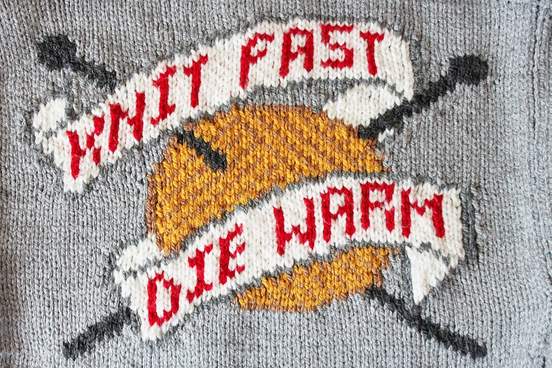
Intarsia
Though all knitting is created using only two stitches—knit and purl—there are hundreds of techniques for manipulating those stitches into new patterns and designs. One such technique is called intarsia. In knitting, it refers to a technique for knitting a large multicolored design that uses different balls of yarn for each of the large areas. In other techniques, such as Fair Isle, the contrasting color is held behind the work and stranded across the back. In intarsia, the edges of the contrasting color are woven together with the edges of the main color so that there's no stranding across the back of the piece. If you turn an intarsia sweater inside out, you'll see a mirror image of the pattern that appears on the outside of the sweater.
The knitting technique takes its name from a woodworking technique that originated in Italy. Intarsia originally referred to a wooden mosaic made of different woods that are fitted together inside a frame. The word is only a few hundred years old—our first written evidence for the English word is from 1867. The word wasn't applied to the knitting technique until the mid-1900s.
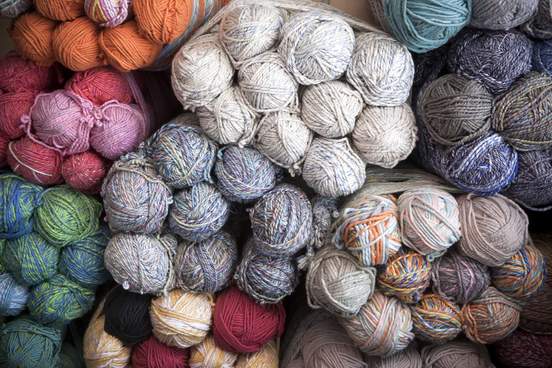
Ravel
Nowadays, knitters associate ravel with the social networking site for knitters, crocheters, spinners, and weavers, Ravelry. The site has knit together (pun intended) fiber artists all over the world, and this makes some sense: the verb ravel can mean "to knit together." It can also mean "to unspool, unknit, or unravel."
Ravel is a contronym (or Janus word): a word with meanings that contradict each other. When ravel came into English in the 1500s, it was used to refer to making something entangled or involved. Our first citation for this word talks of "hurt horses raveled," or confused. Within a hundred years, it went from metaphorical use to literal use and was used of yarn or thread that unspooled and became tangled ("...like a skaine of many threds Running into a rownd and looser liste, It ravels...," 1603) and a garment so undone ("You shall have one woman knit more in a hower then any man can Ravell agen," 1607).
What do you do when your yarn ravels? You untangle it and wind it into a skein again. So it was with ravel: by the mid-1600s, it was being used to refer to disentangling or puzzling out something, and in the early 1800s, it gained the sense "to knit together," first used figuratively and then literally.

Frog
What happens when a knitter decides that a project isn't working? Sometimes they stash it away until they can figure out where they went wrong, and sometimes, they frog it.
Frog is knitting slang for "ripping out" knitting: taking the piece off the needles, and unraveling it quickly. It's not unique to knitting: crocheters frog their work, and needleworkers also frog stitches that aren't right.
We can find use of this particular frog back to 1996, where knitters and needleworkers talked about the frog stitch, used to undo work, on Usenet. The proposed etymology that fiber arts people repeat is that the act of unraveling work is called frogging because you "rip it, rip it," which sounds a lot like "ribbit, ribbit." We're still hunting for an earlier citation that will definitively prove that etymology; in the meantime, one linguist thinks that this meaning of frog might have come about because needlework stitches that are being pulled out end up curling and looping like the decorative curls and loops in a type of closure called a frog.
The word is still the province of fiber crafters and hasn't moved into more general speech, but it's a word we've been watching for a while.
